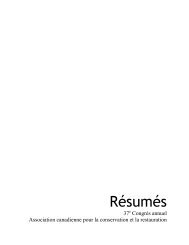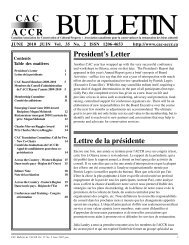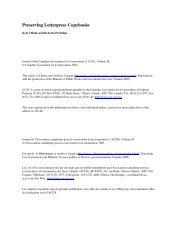Ottawa - Canadian Association for Conservation
Ottawa - Canadian Association for Conservation
Ottawa - Canadian Association for Conservation
Create successful ePaper yourself
Turn your PDF publications into a flip-book with our unique Google optimized e-Paper software.
Collections Risk Assessment at the Denver Museum of Nature & Science<br />
J.A. Southward, H. H. Thorwald, G. Muething, and R.R. Waller<br />
The Denver Museum of Nature & Science (DMNS) received funds from the Institute of Museum<br />
and Library Services - Museums <strong>for</strong> America program to complete a risk assessment of their<br />
collections in storage. The goal of the project was to develop a preservation strategy based on a<br />
systematic and quantitative evaluation of risks. This involved identifying both the loss in the value and<br />
the risk parameters <strong>for</strong> the collections.<br />
The DMNS collections contain more than one million objects in the areas of anthropology, earth and<br />
space sciences, zoology, and library and archives. They are scattered in 49 locations, only one of which<br />
has conditions that meet optimal museum standards. The other 48 locations are crowded and lack<br />
one or more important feature such as fire detection and suppression systems, centralized security,<br />
or temperature and relative humidity controls. These conditions jeopardize long-term stewardship,<br />
restrict public access, and place human safety at risk.<br />
Risk to the collections had been identified in previous conservation assessments. Still, the DMNS<br />
lacked a comprehensive and balanced understanding of all risks affecting collections in storage.<br />
A more holistic understanding was required <strong>for</strong> operational preservation funding. It is critical <strong>for</strong><br />
the inevitable trade-off decisions that will occur in the value engineering phases of facility concept<br />
and design, that are scheduled to being in 2010 as the Museum prepares to build a new collections<br />
storage facility. For example, when cost savings must be found and the Museum is given the choice<br />
of reducing investment in security, climate control, or fire protection, which choice will have the least<br />
impact on any expected long term loss of collection values?<br />
The poster discusses the process and outcomes of the risk assessment as it occurred at the DMNS.<br />
Participating staff came from Research and Collections, Security, Facility Operations, and the Board<br />
Champion <strong>for</strong> Collections. They identified 31 collection units to evaluate. A comprehensive list of<br />
risks was developed based on the Cultural Property Risk Analysis Model (CPRAM) developed at<br />
the <strong>Canadian</strong> Museum of Nature. In this model, the magnitude of risk is measured as the product<br />
of a fraction susceptible, loss in value, probability and extent (MR = FS x LV x P x E). As part of<br />
their own risk assessment, the DMNS identified an average of 91 risks specific to the collection<br />
units. These risks were grouped into categories of rare, sporadic, and continual. As an example, a rare<br />
event in the Denver area would be an earthquake, while some objects on permanent exhibit receive<br />
continual light damage. Staff also identified three kinds of value within each loss of value (LV)<br />
estimate. These were discipline, historic, and public access values.<br />
The technical result of the risk assessment exercise is a comprehensive accounting of all identifiable<br />
risks to the collections. This will serve as a basis <strong>for</strong> rational preservation resource allocation both in<br />
on-going collection care and in new facility design. The less tangible but equally important result<br />
is a vastly improved mutual understanding of collection preservation issues among all parts of the<br />
Museum.





